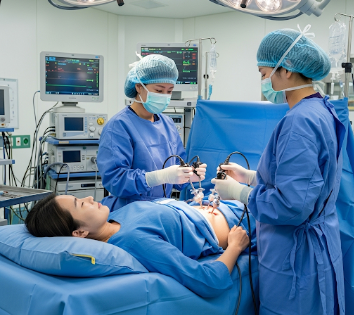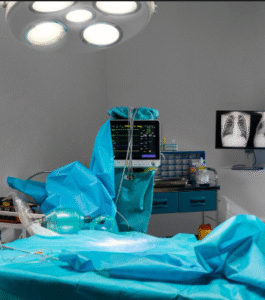Overview
Female sterilisation is a permanent contraception procedure that prevents pregnancy by blocking or sealing the fallopian tubes, preventing eggs from reaching the uterus for fertilization. It is considered a highly effective and long-term method of birth control for women who do not wish to have future pregnancies.
In South Korea, female sterilisation is performed in advanced gynecology and reproductive health centers, using laparoscopic or hysteroscopic techniques. Korean hospitals emphasize safety, minimal invasiveness, and rapid recovery, making it a reliable option for permanent contraception.
What is Female Sterilisation?
Female sterilisation is a surgical procedure that closes or blocks the fallopian tubes, preventing eggs from traveling from the ovaries to the uterus.
It is typically recommended for women who:
- Do not wish to conceive in the future
- Seek a permanent, reliable contraceptive method
- Prefer avoiding long-term hormonal contraception
- Have medical conditions where pregnancy may pose risks
Common techniques include:
- Laparoscopic tubal ligation → small incisions in the abdomen, use of a laparoscope
- Hysteroscopic sterilisation → device inserted into the fallopian tubes via the uterus (non-incisional)
What are the benefits?
Female sterilisation offers several advantages:
- Permanent contraception → eliminates the need for other birth control methods
- ➤ Highly effective → over 99% success rate in preventing pregnancy
- ➤ Minimally invasive options available → laparoscopic and hysteroscopic methods
- ➤ Quick recovery → many patients resume daily activities within a few days
- ➤ No long-term hormonal effects → does not interfere with natural hormone cycles
- ➤ High safety and precision in Korea → modern surgical techniques ensure minimal complications
Procedure Details
1) How should I prepare for Female Sterilisation?
Proper preparation ensures safety and optimal outcomes:
- Medical evaluation → blood tests, pelvic ultrasound, and review of medical history
- Medication adjustment → consult your doctor regarding blood thinners or other medications
- Fasting instructions → generally no food or drink 6–8 hours before surgery if general anesthesia is planned
- Informed consent → discussion of procedure, risks, permanence, and alternative contraception methods
- Transportation → arrange for someone to accompany you after the procedure
2) What happens during the procedure Female Sterilisation?
The procedure typically takes 30–60 minutes depending on the technique:
- Anesthesia → general or local anesthesia with sedation is administered
- Laparoscopic sterilisation:
- Small abdominal incisions are made
- Laparoscope is inserted to visualize fallopian tubes
- Tubes are clipped, cut, cauterized, or sealed
- Hysteroscopic sterilisation:
- Device inserted via the uterus to block fallopian tubes from inside
- No abdominal incision is required
- Closure → incisions (if any) are closed with sutures or surgical glue
- Immediate assessment → ensure procedure success and absence of complications
In Korea, sterilisation procedures prioritize minimally invasive techniques, rapid recovery, and patient comfort.
3) What happens after Female Sterilisation?
- Immediate recovery → monitored in the hospital for anesthesia effects
- Pain management → mild analgesics for abdominal discomfort
- Activity restriction → avoid heavy lifting and strenuous activity for 1–2 weeks
- Follow-up → confirm tubal occlusion through imaging if needed (for hysteroscopic sterilisation)
- Long-term outcome → permanent contraception with very low failure rates
Risks / Benefits
Potential Risks:
- Mild abdominal pain, cramping, or bloating
- Minor bleeding or infection at incision sites (for laparoscopic method)
- Rare complications → injury to surrounding organs, anesthesia risks, or procedural failure
- Regret over permanent contraception → irreversible nature
Key Benefits:
- Permanent and highly effective contraception
- ➤ Minimally invasive with quick recovery
- ➤ Avoids daily or hormonal birth control
- ➤ High safety and precision in Korea
- ➤ Reliable method for women certain about future fertility decisions
Recovery and Outlook
- Short-term recovery → mild discomfort for 1–3 days, gradually improving
- Resumption of normal activity → most patients can return to daily routines within a week
- Long-term outcome → permanent prevention of pregnancy with minimal complications
- In Korea, patients benefit from expert gynecologists, minimally invasive techniques, and thorough post-procedure care
When To Call the Doctor
Contact your healthcare provider if you experience:
- Severe abdominal pain, persistent bleeding, or swelling
- ➤ Signs of infection → fever, redness, or discharge
- ➤ Unusual symptoms → nausea, vomiting, or dizziness
- ➤ Concerns regarding procedure effectiveness
- ➤ Any complications with anesthesia recovery
Prompt evaluation ensures safe recovery and reassurance about the permanence of contraception.
Best Korea Option / Process
South Korea provides world-class female sterilisation services:
- Expert gynecologists → skilled in laparoscopic and hysteroscopic sterilisation
- Advanced surgical techniques → minimally invasive, precise, and safe
- Comprehensive care packages → preoperative evaluation, surgery, and follow-up
- Outpatient or short hospital stay → rapid recovery and minimal disruption
- International patient support → multilingual staff, appointment scheduling, and personalized reproductive health guidance
Patients choosing Korea for female sterilisation can expect safe, highly effective, and minimally invasive permanent contraception, making it a trusted destination for reproductive health in Asia.













